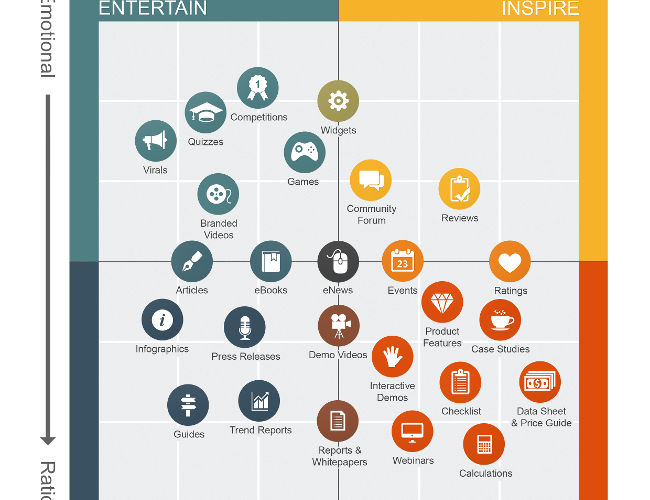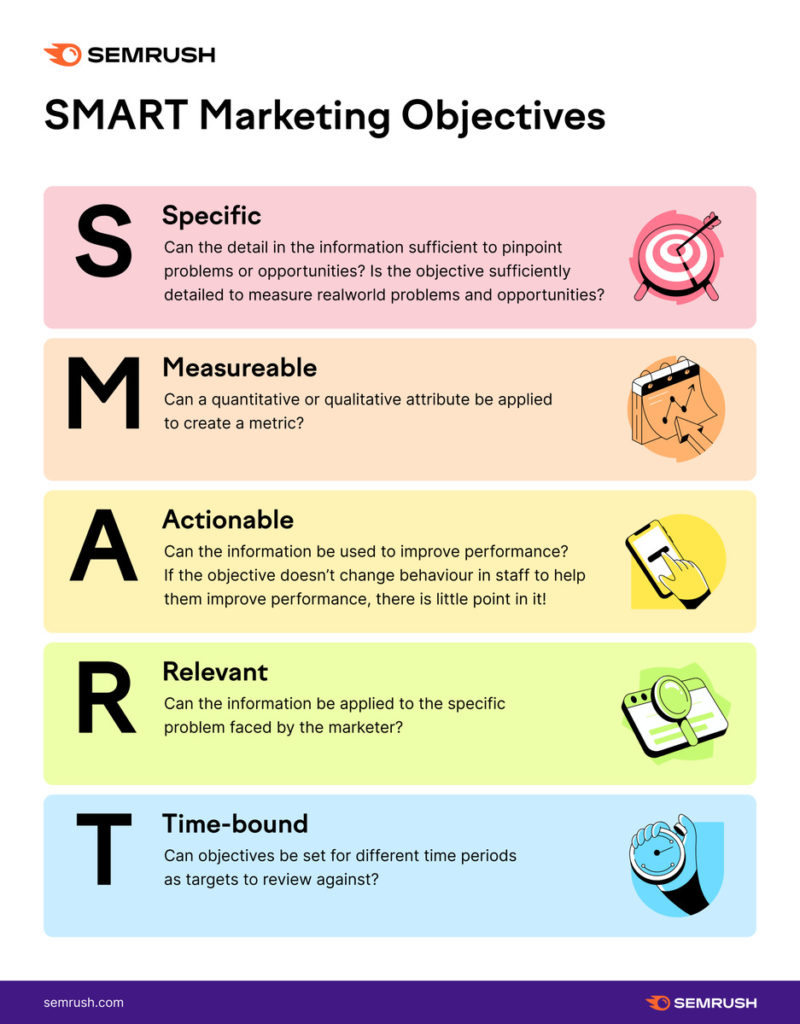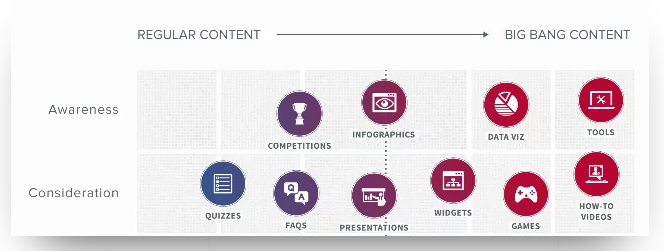The difference between great ideas and great marketing is in the planning. A great idea has the potential to drive traffic and sales, but if you don’t communicate it in the right way to the right people, it will never take off.
In this article, you’ll learn how to plan and validate content using a marketing matrix so your next great idea strikes a chord with your target audience.
What is a marketing matrix and what’s its purpose?
A marketing matrix is a planning tool to help you build marketing campaigns around what your audience engages with. It’s a way to visualize your strategy, allowing you to think in two directions: a potential customer’s interests and their stage in the marketing funnel.
A matrix is a scatterplot that runs on two axes. Take this example by SmartInsights:
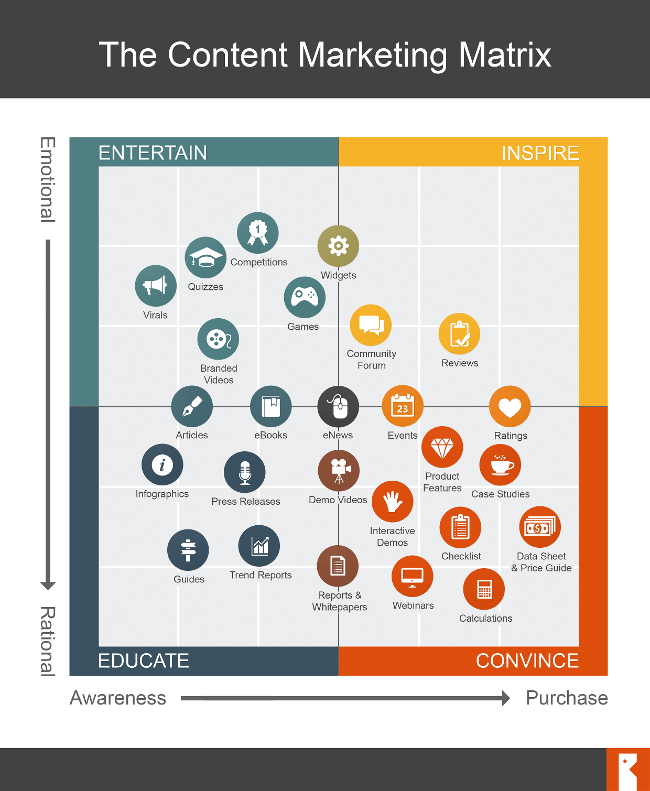
The horizontal axis (X) represents the different stages of the customer journey as people move from awareness to purchase.
The vertical axis (Y) shows the content you need to create to move customers toward purchase. This is based on what neuroscience reveals about purchase behavior: people buy on emotion and justify with logic.
People mostly make buying decisions subconsciously. Emotion communicates the subconscious decision to the conscious mind and the conscious mind searches for logical reasons for our thinking.
What we really think is largely hidden from us. In other words, most of what we know we don’t know we know. Probably 95% of all cognition, all the thinking that drives our decisions and behaviors, occurs unconsciously—and that includes consumer decisions. – Professor Gerald Zaltman [via Harvard Business Review]
To help you come up with ideas, SmartInsights divides its content marketing matrix into four quadrants:
- Entertain;
- Educate;
- Inspire;
- Convince.
These align with the customer journey. For example, if your audience is in the awareness stage, they’re researching a problem. Content like branded videos, articles, or guides entertain and educate prospects to build brand awareness.
As people become familiar with your brand, marketing moves towards consideration and purchase. Introducing ratings or case studies alongside a product demo or webinar can inspire a prospect and convince them to act.
Here’s a slightly different take on the two dimensions matrix from Zazzle Media:
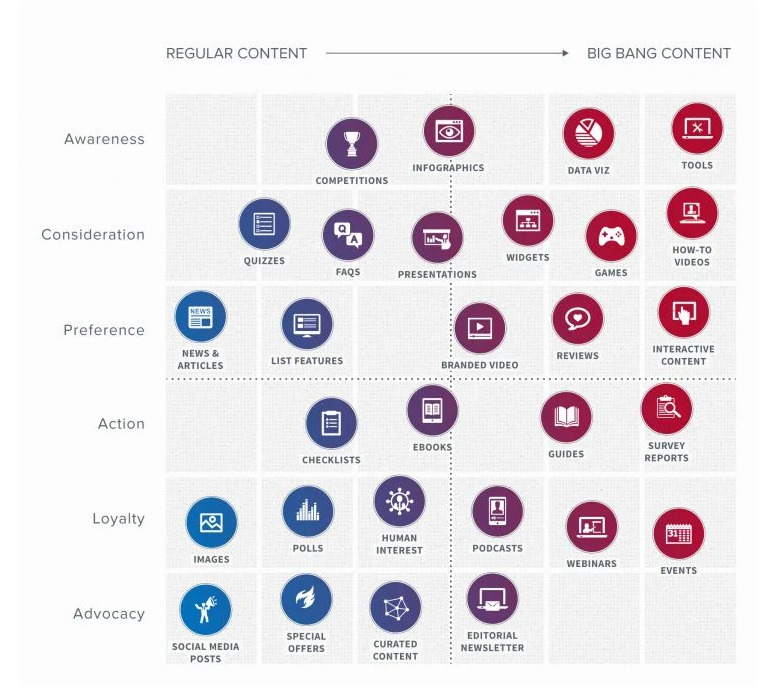
In this example, the y-axis represents the customer journey. However, it goes beyond purchase (action) to include marketing tactics to foster loyalty and advocacy.
Keeping customers happy after an initial transaction helps to increase customer retention. Positive sentiment is also a powerful acquisition tool. The more existing customers recommend you, the less you need to spend on marketing to new ones.
The x-axis represents the type of content that will be used and the type of impact it will have, with Big Bang Content being Zazzle’s most effective.
But its purpose is the same: to provide a framework to map content, evaluate strategy, and identify its strengths and weaknesses.
The benefits of a marketing matrix
A marketing matrix gives you a bird’s eye view of your current efforts. When you’re engaging audiences in various ways to suit each stage in the funnel, seeing the big picture helps you:
- Audit content efficiently;
- Improve marketing planning and content creation;
- Track marketing return on investment (ROI).
Mapping existing assets from top to bottom and left to right makes it easy to see where content lies in each quadrant. From this, you can identify and close content gaps.
For example, if your website generates high traffic but few conversions, a matrix can provide answers. Mapping content might show that your articles are heavily weighted toward educational content. Creating more entertaining content, such as branded videos, can establish emotional connections that bring customers closer to your brand.
As well as highlighting weaknesses, a matrix also spots strengths. Mapping content and measuring the performance of each asset simplifies strategy. If you know what works, produce more of the same and build on it.
For example, if your blog is an effective tool for building brand awareness, dig into your analytics to find out why. What topics get the most traffic? Which posts generate the most backlinks? Which gets people commenting and sharing?
Now, think about how you can expand that topic or repurpose it to engage more people on your blog as they move down the funnel.
Take Close CRM’s blog content.

The brand repurposed this blog post on sales confidence as a video:

This allows them to target a new audience of YouTube viewers and fill a gap at the top of the marketing funnel.
The content answers search intent and solves a problem to build awareness. Close capitalizes on this by expanding on the topic.

Its The Follow Up Formula ebook helps people put what they’ve learned into action. It also strengthens Close’s position as an authority on the subject and a company that helps people solve problems and improve at selling.
Its interactive demo is the next natural step. Showing how its product helps users effectively act on what they’ve learned so far:
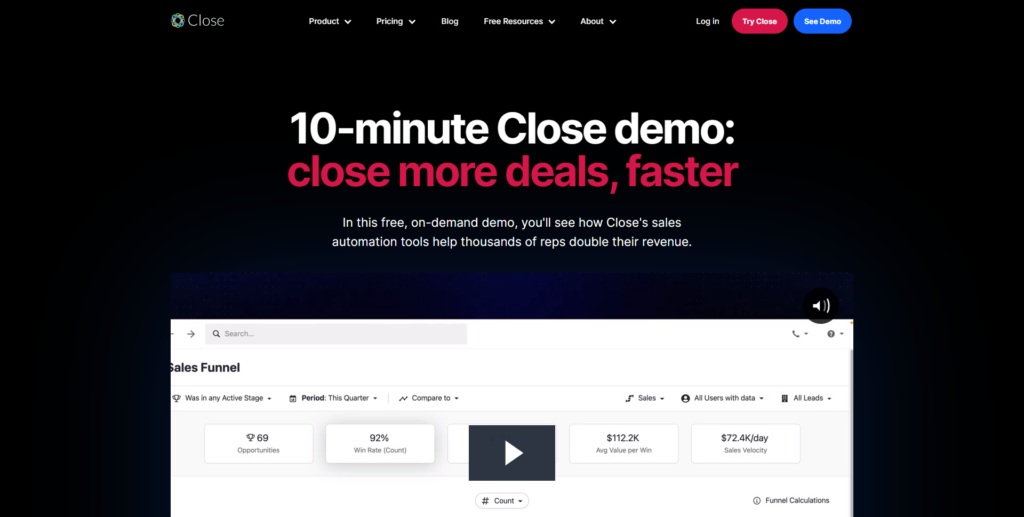
This process can also be reverse-engineered.
For example, if your sales demo successfully converts prospects, look at what related content can get them there. The flow from marketing to sales content helps unite teams, fueling ideas so that each asset benefits the next.
By helping you spot top-performing content, a matrix lets you determine what drives the best results to dedicate budget and resources accordingly.
For example, if drives the most conversions, you can focus on strategies to build your list. Similarly, if another tactic isn’t driving traffic, resources can be rerouted to a more profitable campaign.
How to apply a marketing matrix to your business
To reap the benefits of a marketing matrix, build from the bottom up:
1. Define your target audience;
2. Analyze marketing goals;
3. Map existing content to identify opportunities.
Let’s explore these steps further.
1. Define your target audience
Successful marketing starts by understanding who your customers are and what they need.
When you’re clear on your audience, you’ll focus your efforts on content that engages them, making better use of your time, energy, and resources.
You might have detailed customer personas in your marketing strategy. Even if they are, it’s worth reassessing, especially if current marketing tactics aren’t hitting the mark.
Start by looking at your CRM and data sources like LinkedIn’s Company Directory or Crunchbase for firmographic data. This will help you identify key factors about target customers, such as:
- Industry type;
- Organization size;
- Revenue;
- Location;
- Ownership structure;
- Growth trends.

The information gives you insight into how your product might be relevant by answering questions like:
- Who is the lead?
- Where do they work?
- What is their position?
Supplement with source data. Look at your analytics and talk to customers to find out:
- How people find you. What brings people to your website? What types of prospects make up your largest demographic of visitors?
- What interests your prospects. Where are people coming from? Are they looking for broad or targeted information?
For example, if somebody visits your website from a comparison site like Capterra, you can assume that they know about your product, but are assessing their options.
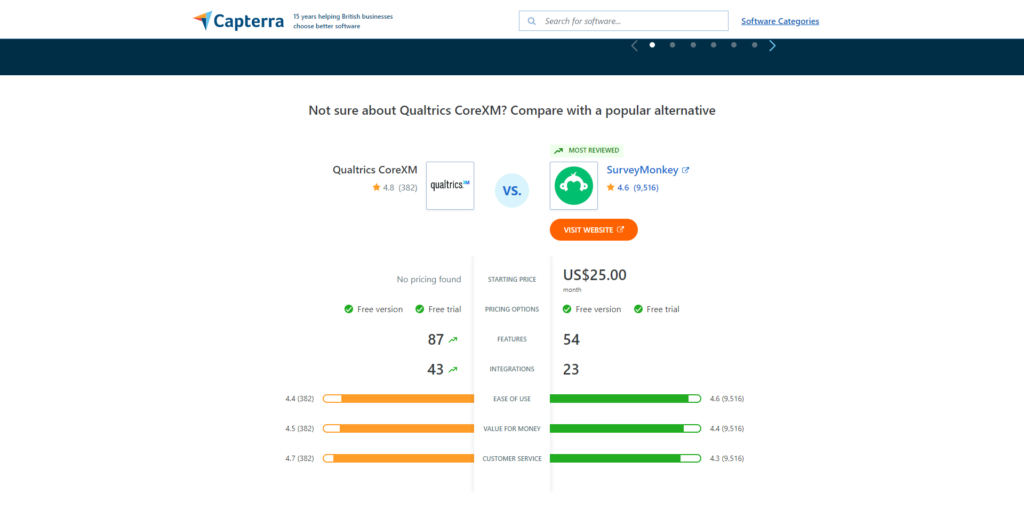
How you engage this visitor will be different than somebody who has landed on your blog via a branded search on Google.
Finally, analyze customer behavior. How people interact with your business will help you establish where they are in the buyer’s journey and inform the type of content to prioritize.
For example, a person clicking through to your landing page from a press release is likely learning about your business. Whereas, a person visiting a pricing page likely knows what your product does and is thinking about purchasing.
When you’re clear on who you’re targeting, you can establish what you want marketing to achieve.
2. Analyze your marketing goals
To move your business forward, goals have to be well-defined and measurable.
For example, a goal to “increase email conversions” is too vague to assess performance. However, a goal to “earn ten clients from our current list using email marketing” is measurable.
Assess your current marketing goals against the SMART framework. Each goal should be:
- Specific;
- Measurable;
- Actionable;
- Relevant;
- Time-bound.
If a goal doesn’t contribute to you getting where you need to be, re-evaluate it with numbers:
Step 1. Identify how much revenue you need to make from your marketing efforts. For example, if you made $500,000 in sales and aim to grow by 30% next year, you need to make $650,000. You can look at how much guaranteed sales income you have for next year and deduct that from the total to determine how much you need to close.
Step 2. Establish how many sales you need to hit your target. For example, if you need to make $200,000 to meet revenue goals and your average sale is $10,000, you need 20 new customers.
Step 3. Use your close rate to determine how many opportunities you’ll need. For example, if your close rate is 25% and you need 20 customers, you’ll need 80 opportunities.
Step 4. Identify how many leads you need. Look at your data to determine how many prospects become marketing-qualified leads (MQLs) and how many become sales-qualified leads (SQLs).
Step 5. Use lead data to determine how many leads to generate. Using our revenue example, if 50% of prospects become MQLs and SQLs, you’d need to capture around 320 MQLs in the next year, which will turn into 160 SQLs for the sales team to get 80 opportunities (and 20 sales).
Step 6. Estimate how much traffic you’ll need to reach your goal. Look at your traffic to lead conversion rate to work out how many people marketing needs to drive to your website. If your conversion rate is 2.5%, using our example, you’d need around 30,000 visitors, which will turn into 750 leads, who will become 320MQLs, and so on until you meet your sales target.
When you’re clear on your goal, set monthly or quarterly benchmarks. For example, for Q1 you might set a target of 5,000 visitors. As your marketing ramps up, by Q4 you might set a higher target of 15,000 visitors.
Once you know what you want marketing to achieve, look at which of your current channels can contribute to your objectives.
3. Map existing content to identify opportunities
To develop content that meets audience needs and your goals, evaluate your marketing strategy.
Map assets based on:
- Where they fit into the buyer’s journey. Which content works best for awareness, consideration, action, loyalty, and advocacy?
- How they appeal to the customer. Is your content more emotional (e.g., a viral video) or rational (e.g., a whitepaper)? Is it regular content you can produce in volume (e.g., social media posts) or big bang content that requires more resources but delivers better results (e.g., a webinar or event)?
Look at content performance to analyze strengths and weaknesses.
- How much traffic does it drive?
- How many shares, comments, and likes does it get?
- How many leads does it convert?
Use this information to place content accordingly in the matrix. For example, in Zazzle Media’s matrix, we can see that how-to videos are most effective for visitors considering their options. They’re also among the most resource-heavy to produce.
Anything that doesn’t contribute towards your goal is a weakness to improve or drop from your marketing strategy. Any gap in your matrix is an area to exploit.
Some gaps stand out from the way content fits into the matrix. For example, a lack of leads converting to customers may be evident in a lack of sales enablement content (e.g., case studies, pricing page, or a product demo).
Others may be harder to spot. To identify new content opportunities, run a competitive matrix. Research competitor marketing channels to identify how they reach customers and promote products. Use a tool like SimilarWeb or Semrush to find out:
- Audience size and demographics;
- Where visitors come from;
- Which keywords drive traffic;
- Which categories drive referrals;
- Which topics audiences are interested in.
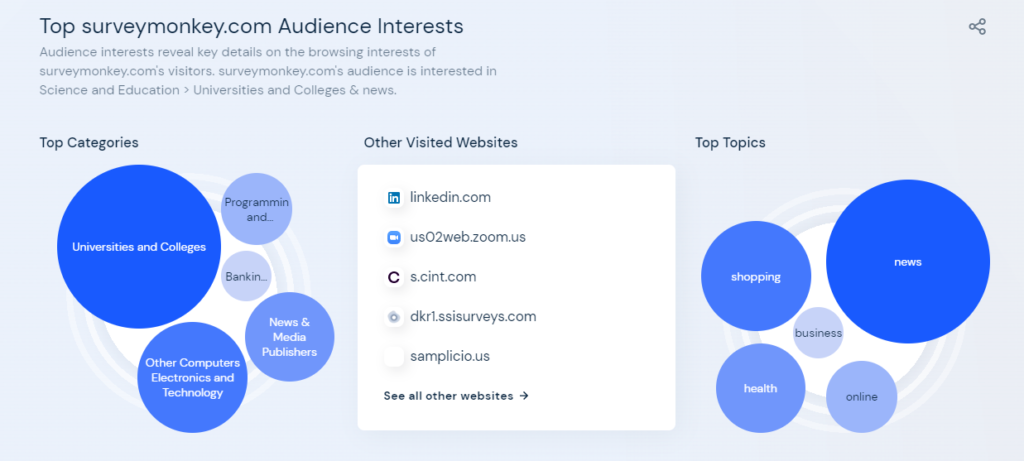
Map competitor content and compare it to your own.
- What are competitors doing that you aren’t?
- What are you doing that competitors aren’t?
- What are you doing better or worse?
- Where are the gaps?
Knowing how you compare to competitors will help you brainstorm ideas to differentiate your offer. It also gives you a benchmark to work..
Source link


